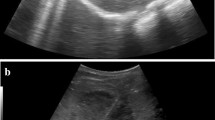Summary
We have performed CT-guided percutaneous needle aspiration in 104 patients with severe pancreatitis strongly suspected of harboring pancreatic infection on the basis of systemic toxicity and CT findings (Balthazar CT grade D or E). Of these 104 patients, 51 (49%) were documented with pancreatic infection. Gram stain was positive in 54 of 58 infected aspirates, and culture was positive in all 58. Klebsiella,Escherichia coli, andStaphylococcus aureus were the most frequent organisms. Eighty-six percent of infected processes contained only one organism. Overall, pancreatic infection was documented by GPA within the first 2 wk in approx one-half of patients. There were no complications. The overall rate of infection decreased from 60 (1980–1987) to 34% (1988–1995) (p=0.01). This change was caused by a reduction in the rate of infected necrosis from 67 to 32% (p=0.015). The overall mortality rate remained at 20%. The mortality of sterile pancreatitis was not different from infected pancreatitis (p=0.14). We conclude that GPA is a safe, accurate method of diagnosis of pancreatic infection. The rate of pancreatic infectoon appears to be decreasing. The overall mortality of severe pancreatitis among patients suspected of harboring pancreatic infection has remained unchanged because of the high mortality associated with both infected necrosis and severe sterile necrosis.
Similar content being viewed by others
References
Bittner R, Block S, Buchler M, Beger HG. Pancreatic abscess in infected pancreatic necrosis: different local septic complications in acute pancreatitis.Dig Dis Sci 1987; 32: 1082–1087.
Fedorak IJ, Ko TC, Djuricin G, McMahon M, Thompson K, Prinz RA. Secondary pancreatic infections: are they distinct clinical entities?Surgery 1992; 112: 824–831.
Stanten R, Frey CF. Comprehensive management of acute necrotizing pancreatitis and pancreatic abscess.Arch Surg 1990; 125: 1269–1275.
Rattner DW, Legermate DA, Lee MJ, Mueller PJ, Warshaw AL. Early surgical debridement of symptomatic pancreatic necrosis is beneficial irrespective of infection.Am J Surg 1992; 163: 105–110.
Pederzoli P, Bassi C, Vesentini S, Campedelli A. A randomized multicenter clinical trial of antibiotic prophylaxis of septic complications in acute necrotizing pancreatitis with imipenem.Surg Gyn Obstet 1993; 176: 480–483.
Gerzof SG, Banks PA, Robbins AH, Johnson WC, Spechler SJ, Wetzner SM, Snider JM, Langevin RE, Jay ME. Early diagnosis of pancreatic infection by computed tomographyguided aspiration.Gastroenterol 1987; 93: 1315–1320.
Bradley EL III. A clinically based classification system for acute pancreatitis.Arch Surg 1993; 128: 586–590.
Balthazar EJ, Robinson DL, Megibow AJ, Ranson JHC. Acute pancreatitis: value of CT in establishing prognosis.Radiology 1990; 174: 331–336.
Karimgani I, Porter KA, Langevin RE, Banks PA. Prognostic factors in sterile pancreatic necrosis.Gastroenterol 1992; 103: 1636–1640.
McFadden DW, Reber HA. Indications for surgery in severe acute pancreatitis.Int J Pancreatol 1994; 15: 83–90.
Steiner E, Mueller PR, Hahn PF, Saini S, Simeone JF, Wittenberg J, Warshaw AL, Ferrucci JT Jr. Complicated pancreatic abscesses: problems in interventional, management.Radiol 1988; 167: 443–446.
Hariri M, Slivka A, Carr-Locke DL, Banks PA. Pseudocyst predisposes to infection when pancreatic necrosis is unrecognized.Am J Gastroenterol 1994; 89: 1781–1784.
Lucarotti ME, Virjee J, Alderson D. Dynamic computed tomography in acute pancreatitis.J Surg 1993; 80: 1393–1395.
Ferguson CM, Bradley EL III. Can markers for pancreatic necrosis be used as indicators for surgery?Am J Surg 1990; 160: 459–461.
Bradley EL III, Allen K. A prospective longitudinal study of observation versus surgical intervention in the management of necrotizing pancreatitis.Am J Surg 1991; 161: 19–24.
Sarr MG, Nagorney DM, Mucha P Jr, Farnell MB, Johnson CD. Acute necrotizing pancreatitis: management by planned, staged pancreatic necrosectomy/debridement and delayed primary wound closure over drains.Br J Surg 1991; 78: 576–581.
Crass RA, Meyer AA, Jeffrey RB, Federle MP, Grendell JH, Wing VW, Trunkey DD. Pancreatic abscess: impact of computerized tomography on early diagnosis and surgery.Am J Surg 1985; 150: 127–130.
Hill MC, Dach JL, Barkin J, Isikoff MB, Morse B. The role of percutaneous aspiration in the diagnosis of pancreatic abscess.Am J Radiol 1983; 141: 1035–1038.
Stiles GM, Berne TV, Thommen VD, Molgaard CP, Boswell WD. Fine needle aspiration of pancreatic fluid collections.Am Surgeon 1990; 56: 764–768.
Hiatt JR, Fink AS, King W III, Pitt HA. Percutaneous aspiration of peripancreatic fluid collections: a safe method to detect infection.Surgery 1987; 101: 523–530.
Sunday ML, Schuricht AL, Barbot DJ, Rosato FE. Management of infected pancreatic fluid collections. AmSurgeon 1994; 60: 63–67.
van Sonnenberg E, Wittich GR, Casola G, Stauffer AE, Polansky AD, Coons HG, Cabrera OA, Gerver PS. Complicated pancreatic inflammatory disease: diagnostic and therapeutic role of interventional radiology.Radiol 1985; 155: 335–340.
Fink AS, Hiatt JR, Pitt HA, Bennion RS, et al. Indolent presentation of pancreatic abscess.Arch Surg 1988; 123: 1067–1072.
Sostre CF, Flournoy JG, Bova JG, Goldstein HM, Schenker S. Pancreatic phlegmon.Dig Dis Sci 1985; 30: 918–927.
Author information
Authors and Affiliations
Rights and permissions
About this article
Cite this article
Banks, P.A., Gerzof, S.G., Langevin, R.E. et al. CT-guided aspiration of suspected pancreatic infection. Int J Pancreatol 18, 265–270 (1995). https://doi.org/10.1007/BF02784951
Received:
Revised:
Accepted:
Issue Date:
DOI: https://doi.org/10.1007/BF02784951




